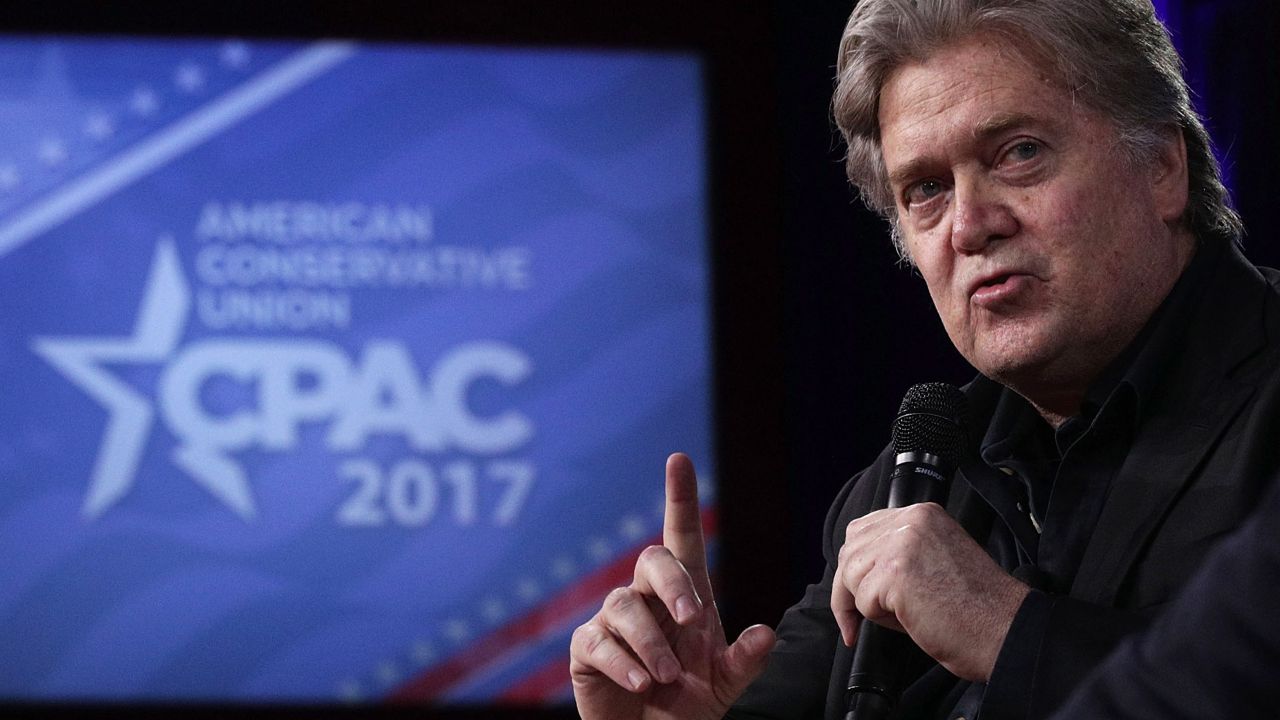
White House Chief Strategist Steve Bannon participates in a conversation during the Conservative Political Action Conference (CPAC) at the Gaylord National Resort and Convention Center Feb. 23, 2017 in National Harbor, Maryland. (Photo by Alex Wong/Getty Images)
NATIONAL HARBOR, MARYLAND — Movement conservatism is dead, and Donald Trump killed it. How else to explain the spectacle that is the 2017 Conservative Political Action Conference?
During the race for the 2016 Republican presidential nomination, many self-described conservatives fell all over themselves declaring that Trump was not one of their number. On Thursday, the American Conservative Union (ACU), which sponsors the annual conference known as CPAC, celebrated the Trump administration from its main stage, featuring the administration’s top figures in various formats, including a rare public interview with chief White House strategist Stephen K. Bannon, the “economic nationalist” who prides himself on having provided “the platform for the ‘alt-right’” during his tenure as chief executive of Breitbart News.
“Alt-right,” of course, is the sanitizing term applied to a collection of hate groups and their leaders — groups that forthrightly declare white supremacy, misogyny, homophobia, Islamophobia and/or anti-Semitism as part of their ideology. Movement conservatism, on the other hand, has attempted, since Barry Goldwater’s 1964 presidential bid, to express those same prejudices processed through the language of such grand philosophical principles as individual liberty, the beauty of small government and the moral hazard of allowing government to keep poor people from going hungry.
Trump and his advisers were savvy in their recognition that the same fuel of anger and resentment that animated conservatism no longer required those ideological trappings, and could be tapped in the service of the businessman’s ideologically squishy campaign for the presidency. Trump repeatedly retweeted posts from white supremacist accounts during the campaign, amplifying smears against African-Americans and others, engaging voters outside the “alt-right” pool by normalizing the movement’s rhetoric.
If this year’s CPAC is any indication, conservatives are keen to claim Trump’s victory as their own. (The conference’s first day featured such high-profile administration figures as Bannon, who appeared with Trump’s chief of staff Reince Priebus; Vice President Mike Pence; presidential counselor Kellyanne Conway and Education Secretary Betsy DeVos.) But now that the “alt-right,” personified by Bannon, is in the White House, conservative leaders are at sixes and sevens, trying to assess the correct place for the “alt-right” within the greater movement.
Just hours before ACU Chairman Matt Schlapp spoke with Bannon and Priebus, ACU Executive Director Dan Schneider preposterously declared “alt-right” to be a once-noble term that has been “hijacked” by a “left-wing fascist group.” He added: “They stole the term specifically to confuse us.”
The group to which Schneider referred without naming it was the white nationalist National Policy Institute (NPI) helmed by Richard B. Spencer. “They met just a couple months ago in Washington, DC, to spew their hatred and make their ‘Heil Hitler’ salutes,” Schneider said. (He neglected to mention that attendees of NPI’s Nov. 19 conference were hailing Trump — hardly a left-winger — as they raised their arms.)
An hour later, Spencer himself arrived at CPAC, where a show was made of escorting him off the property of the Gaylord National Resort & Convention Center, where the conference is taking place — but only after he was permitted to hold court with journalists for more than 30 minutes, as reported by Jennifer Jacobs of Bloomberg News.
But even before CPAC’s opening session, the American Conservative Union had an “alt-right” problem, one of its own making, when it abruptly announced the addition of right-wing provocateur Milo Yiannopoulos as a conference keynoter, then just as abruptly rescinded the invitation when a video went viral showing Yiannopoulos endorsing the sexual abuse of pubescent boys by Roman Catholic priests. Until the video, that Yiannopoulos is infamous for outrageous expressions of racism and misogyny was apparently of little concern to CPAC leaders. They wanted the draw — the cool kid up onstage.
The truth is that with the ascendance of Bannon as chief White House strategist, in right-wing circles the “alt-right” is where the energy is today. Yiannopoulos, if not Bannon’s creation, was one of his stars at Breitbart News — the senior editor who Peter Montgomery of Right Wing Watch called the right’s gay enfant terrible. Yiannopoulos was responsible for penning such gems as “Birth Control Makes Women Unattractive and Crazy.”
After the protest of a scheduled Yiannopoulos lecture at University of California, Berkeley turned violent earlier this month, the provocateur was all set for a treasured role at CPAC as a victim of what Trump likes to call “political correctness.” But after the viral video debacle, Yiannopoulos resigned from Breitbart in the face of a threatened staff revolt.
Steve Bannon and Reince Priebus appeared on the CPAC stage for a softball interview by ACU’s Schlapp. The purpose of the appearance — Bannon’s first in a televised setting since he won his West Wing job — apparently was to dispel media reports of a war between the two men. It is unlikely that any in the media, repeatedly referred to during the interview as “the opposition party” by Bannon, were convinced.
Asked by Schlapp what he liked about Bannon, Priebus was effusive, calling the strategist “a very dear friend,” and lauding Bannon’s “loyalty” to the president. For his part, Bannon could only muster some admiration for Priebus’s quiet determination to enact Trump’s agenda and keeping the wheels in motion. “His job is by far one of the toughest jobs I’ve ever seen in my life,” Bannon said, “to make the trains — ” He abruptly shifted before the words “run on time” could leave his mouth, perhaps suddenly realizing that a reference to Mussolini could be problematic. Bannon finished the sentence with a non-sequitur: “ — and you only see the surface.”
Such discernment, however, did not dissuade the president’s chief strategist from describing his opponents as “the globalist, corporatist media,” which some read as an anti-Semitic dog-whistle, a kind of code for the more baldly stated Yiannopoulos description of a BuzzFeed reporter as “a typical example of a sort of thick-as-pig-s**t media Jew who has all these sort of right, PC politics.”
Even if he evokes uneasy feelings in some old-school movement conservatives, Bannon had plenty to offer them: a promise to “deconstruct the administrative state,” deregulate business and assert national sovereignty through immigration and trade policy. Yet few in the audience seemed troubled by his description of Trump’s agenda as economic nationalism, a way of saying that trading partners who fall afoul of the administration will be punished with tariffs and other barriers to exporting to the United States, a philosophy at odds with the so-called free-market capitalism that conservatives have long claimed as a boon to economic prosperity.
Neither individual liberty nor moral hazards were discussed.
Then-presidential candidate Donald Trump canceled his scheduled appearance at last year’s CPAC over a disagreement with ACU about the format for his session. Like all the other presidential candidates who appeared on the CPAC stage, Trump was expected to take questions from an onstage interviewer, and he was having none of it.
On Friday morning, Trump addressed CPAC as president of the United States, and the ACU is leading the cheers for his administration. Opening his interview of Priebus and Bannon, Schlapp laid on the praise: “I think the first thing that would be appropriate, after 30 days of running a continual sprint, is to thank these two guys for what they have been doing,” Schlapp said. The audience expressed its appreciation with an enthusiastic round of applause.
Bannon, the builder of the “alt-right’s” platform, was in the house, and the American Conservative Union was all in, as it prepared to welcome the president who killed any notion of conservatism as a movement based on principle.




